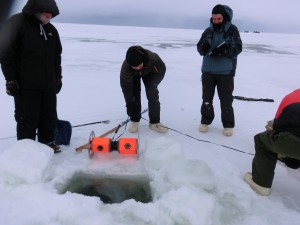11 December 2013
Buoyant rover records Arctic ice from beneath
Researchers have developed a rover that floats beneath the surface of the ice and photographs it from underneath. The upside down images could help scientists understand the source of methane bubbles trapped in Arctic ice, and how much of this powerful global warming gas is seeping from the permafrost.
Engineer Daniel Berisford and his colleagues at the Jet Propulsion Lab in Pasadena, Calif., deployed the rover in a shallow lake near Barrow, Alaska in November.

Researchers deploy a buoyant rover prototype in an ice-covered lake near Barrow, Alaska. Credit: Ralph Lorenz/ Johns Hopkins University Applied Physics Lab.
The North Slope of Alaska has about 10,000 shallow lakes that dot the landscape. Many have methane seeps beneath them that cause the lake to bubble like a hot tub. Although some gas comes from geological processes, most methane in the Arctic is believed to come from the microbial breakdown of organic matter. Some lakes have deposits of gas generated by ancient microbes, while others release methane that was just recently churned out.
“One of the big pushes of this whole study is to determine how much of it is from modern fermentation, and how much of it is trapped in pockets deep down from ancient fermentation, which is coming out of the cracks as the permafrost melts,” Berisford said during a poster session Monday afternoon at the American Geophysical Union’s Fall Meeting.
The rover is about two feet long and narrow enough to go down a borehole. The central cylinder has sawtooth wheels to help it grip the ice, and a neutrally buoyant tail that holds chemical monitoring equipment. At a cost of $15,000, if it gets lost beneath the ice, “it’s not like losing an ROV,” Berisford said, referring to the much larger and more expensive “remotely operated vehicles” used for underwater exploration.
Besides a camera and a light, the rover is equipped with a variety of sensors. It can detect dissolved oxygen and methane, as well as the water’s pH, temperature, and conductivity.
The rover captured one image of a methane bubble trapped within the ice that contained several striations. Berisford does not know whether the stripes represent seasonal variation, or simply the changing output of the seep. Continued monitoring by the rover could help explain how gas bubbles change and grow.
Methane seeps from permafrost are of great interest to researchers studying climate change because the Arctic will likely release more gas as it warms. “People are really concerned with the artic,” said Berisford. “We’re just trying to understand the whole system.”
The rover has no tether and researchers can control the rover with a tablet, and see what the camera sees in real time by using goggles. They can also control the movement of the rover and receive data via an iridium satellite from their lab at JPL.
Future versions of the rover will canvas the undersides of sea ice for months at a time. “Ultimately we want to do really long term deployments – for an entire season – so if you do that, you have to be able to control it remotely,” said Berisford.
– Patricia Waldron is a science communication graduate student at UC Santa Cruz










 GeoSpace is a blog on Earth and space science, managed by AGU’s Public Information staff. The blog features posts by AGU writers and guest contributors on all sorts of relevant science topics, but with a focus on new research and geo and space sciences-related stories that are currently in the news.
GeoSpace is a blog on Earth and space science, managed by AGU’s Public Information staff. The blog features posts by AGU writers and guest contributors on all sorts of relevant science topics, but with a focus on new research and geo and space sciences-related stories that are currently in the news.